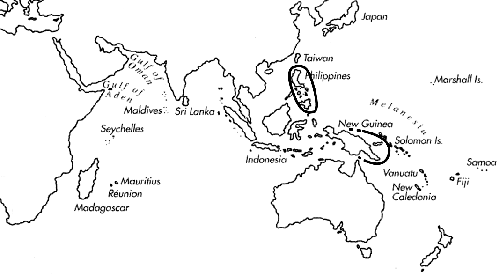Range: Philippines and Papua New Guinea.
Description: Light-coloured form (see Discussion) moderately small, moderately light to moderately solid. Last whorl conoid-cylindrical to ventricosely conical; outline convex at adapical third, less so below; left side convex near base. Aperture wider below centre than near shoulder. Shoulder angulate to subangulate. Spire of low to moderate height, outline deeply concave. Teleoconch sutural ramps flat, with 1-2 increasing to 4 wide spiral grooves. Last whorl with axially striate spiral grooves from base to centre; intervening ribbons grade to ribs near base. Dark-coloured form (see Discussion) medium sized and moderately solid. Last whorl more conical than in other form. Shoulder angulate. Spire of moderate height; outline concave, with late spire whorls more raised than in lightcoloured form. Larval shell of 2 or more whorls, maximum diameter about 0.8 mm. Teleoconch sutural ramps with 1 increasing to 6-8 spiral grooves; ribs between variably broad. Last whorl with spiral grooves to centre or shoulder; intervening ribbons grade to ribs below shoulder.
| Shell Morphometry | ||
|---|---|---|
| L | - | |
| RW | - | |
| RD | - | |
| PMD | - | |
| RSH | - | |
Ground colour white. In light-coloured shells, last whorl with about 15 spiral rows of brown spots that may fuse axially; markings somewhat concentrated below shoulder, and on each side of centre. Larval whorls and adjacent postnuclear sutural ramps white. Following ramps with brown radial markings. Aperture white. In dark-coloured shells, spiral rows consists of larger dark brown spots and bars; markings sparse within a spiral band below centre. Additional fine brown dots and axial dashes on subcentral band and sometimes at shoulder. Larval whorls and adjacent postnuclear sutural ramps white to light brown. Radial markings on following ramps large and dark brown. Aperture white, becoming orange deepwithin in large specimens.
Habitat and Habits: Reported from 20- 100 m.
Discussion: C. blanfordianus resembles C. collisus, C. spectrum, and C. jickelii. The latter species has a more conical last whorl (PMD 0.83-0.89) and its aperture is narrower, of more uniform width. For comparison with C. collisus and C. spectrum, see the Discussions of those species. The holotype of C. blanfordianus is lost. The specimen figured by Coomans et al. (1982) does not appear to be conspecific with the specimen depicted by Crosse. Two groups of shells correspond to Crosse's original figure (Pl. 37, Fig. 29): Moderately small and light shells from Papua New Guinea and Philippines (Pl. 37, Figs. 26-28) and medium sized shells with darker and coarser pattern from Philippines (Pl. 37, Figs. 24, 25). Which of these forms is more similar to the type of C. blanfordianus cannot be unequivocally decided by the original figure. It is uncertain as well, whether both forms belong to the same species or not. The smaller shells are in better accordance with Crosse's original description; therefore, we assign the larger shells only provisionally to C. blanfordianus. The latter shells are very similar to C. zapatosensis; for comparison, see the discussion of the latter species.

C. blanfordianus range map
This section contains verbatim reproductions of the accounts of 316 species of Conus from the Indo-Pacific region, from Manual of the Living Conidae, by Röckel, Korn and Kohn (1995). They are reproduced with the kind permission of the present publisher, Conchbooks.
All plates and figures referred to in the text are also in Röckel, Korn & Kohn, 1995. Manual of the Living Conidae Vol. 1: Indo-Pacific Region.
The range maps have been modified so that each species account has it own map, rather than one map that showed the ranges of several species in the original work. This was necessary because each species account is on a separate page on the website and not confined to the order of accounts in the book.